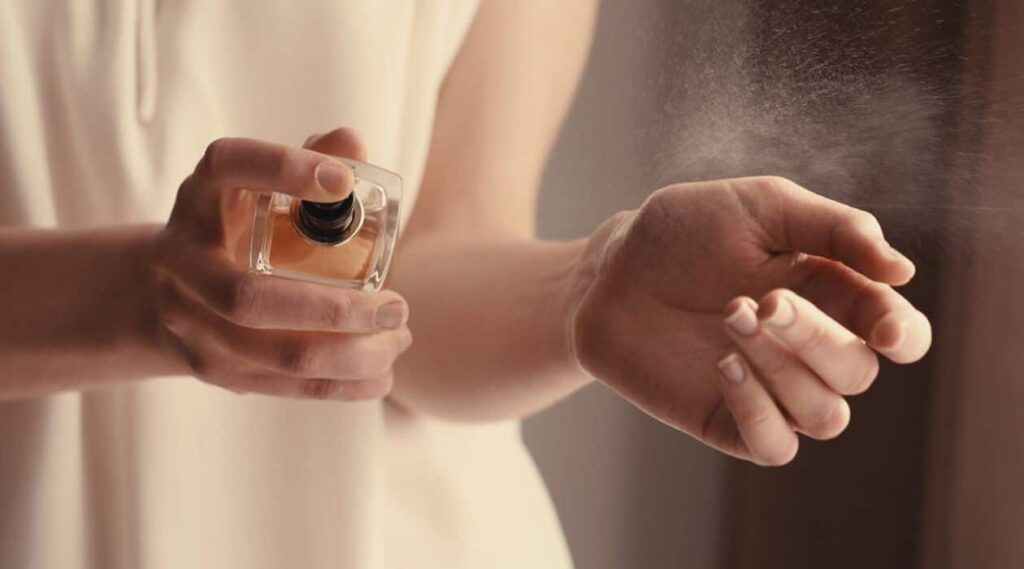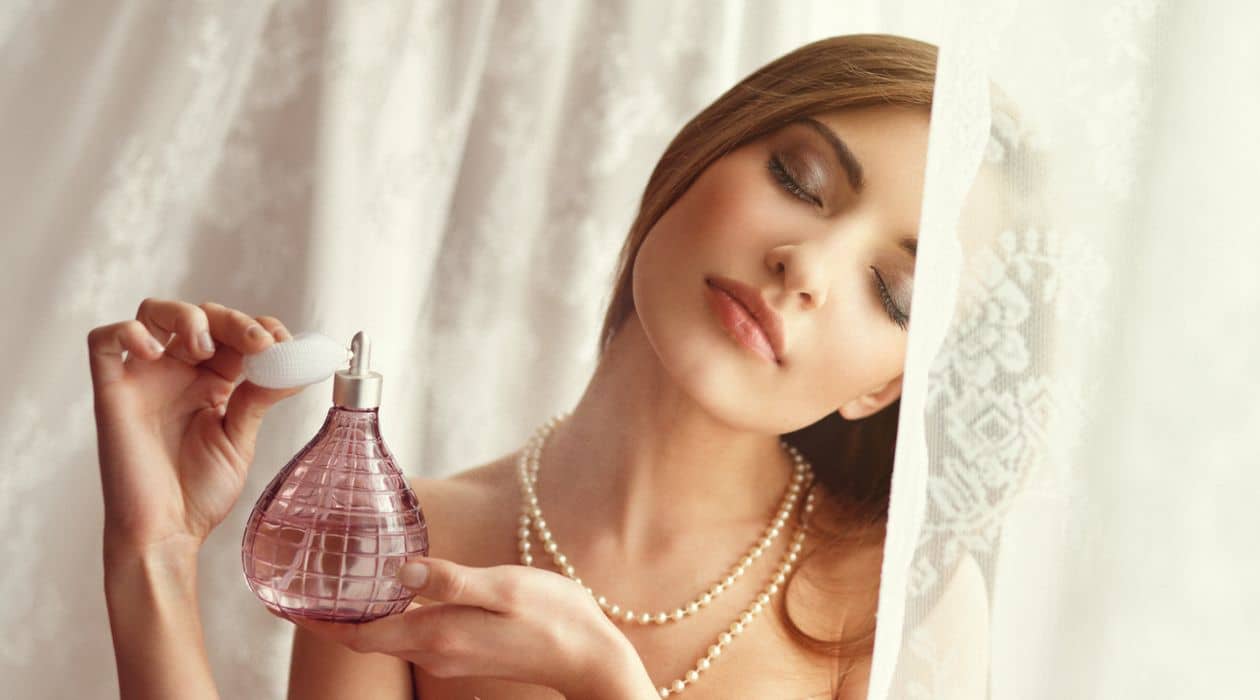Have you ever wondered where the captivating scent of a lady’s perfume goes? Like a delicate dance, the fragrance diffuses through the air, leaving a trail of enchantment in its wake. This article unravels the secrets behind the invisible journey of perfume, exploring the interplay between fragrance and fabrics, as well as the chemistry that allows it to linger on the skin. Join us as we embark on a scientific exploration of the captivating world of perfume.
Key Takeaways
• Fragrance diffusion refers to the release of fragrance molecules into the air, and it is influenced by environmental factors such as temperature and humidity.
• Perfume has the power to evoke emotions, memories, and create a sense of identity, as it combines with an individual’s unique body scent to create a one-of-a-kind fragrance.
• The longevity of a fragrance is determined by the precise measurement and combination of scent molecules, as well as the individual’s body chemistry and ingredient quality.
• Different fabrics can enhance or alter the scent profile of a perfume, with natural fiber compositions tending to absorb and retain scents better, and different fabrics having affinities for specific scent families.
The Science Behind Fragrance Diffusion
The article explores the intricate mechanisms and processes involved in the diffusion of fragrance, shedding light on the science behind it. Fragrance diffusion refers to the way in which the scent of a fragrance is released into the air. When a person sprays or applies perfume from a bottle, the fragrance molecules are released into the surrounding air. These molecules then interact with the surrounding environment, such as the temperature and humidity, which can affect the way the scent spreads. Fragrances are typically composed of various ingredients, including base notes, which provide the foundation for the fragrance, and top notes, which are the initial scents that are detected. For example, a perfume may contain a patchouli note as a base note, and a rose note as a top note. The combination of these ingredients and their interaction with the environment ultimately determine how the fragrance diffuses and spreads.
The Invisible Journey of Perfume
An invisible journey of perfume unfolds as the scent molecules invisibly navigate their way through the air, enchanting those who catch a whiff. The scent of perfume is a powerful aspect of personal grooming. It has the ability to evoke emotions, memories, and even create a sense of identity. The beautiful scent of a lady’s perfume is a reflection of her personality and style. Each individual has their own unique body scent, and when combined with a carefully chosen perfume scent, it becomes a fragrance family that is truly one-of-a-kind. Authentic fragrances are crafted with precision, blending various notes to create a classic fragrance that stands the test of time. A fragrance collection is often curated to include different scents for different occasions, allowing one to choose their signature scent based on mood and preference. The lady’s scent is an expression of her individuality, making perfume an essential part of her daily routine.
Unraveling the Secrets of Fragrance Longevity
One key factor in understanding fragrance longevity lies in the precise measurement and combination of scent molecules. Perfume is a complex blend of various ingredients, carefully selected and crafted by perfumers like Frederic Malle and Dominique Ropion. Fragrance companies meticulously curate the ingredient list to create a harmonious scent that will endure throughout the day. For instance, Geranium Pour Monsieur by Frederic Malle is known for its long-lasting scent due to the skillful combination of geranium, mint, and anise. These scent molecules interact with the skin, releasing fragrance over time. However, the longevity of a fragrance also depends on other factors, such as the individual’s body chemistry and the quality of ingredients used. Exploring the interplay between perfume and fabrics further enhances the understanding of fragrance longevity, as different fabrics can either absorb or repel scent molecules, affecting the overall scent experience.
Exploring the Interplay Between Perfume and Fabrics

Understanding the complex relationship between perfume and fabrics allows for a comprehensive analysis of how different materials can both absorb and release scent molecules. When it comes to fragrance for women, the interplay between perfume and fabrics adds another layer to the scent experience. Here are three key points to consider:
• Scent profile: Different fabrics can enhance or alter the scent profile of a perfume. For instance, fabrics with a natural fiber composition tend to absorb and retain scents better than synthetic fabrics.
• Complementary scents: Some fabrics have a natural affinity for specific scent families. For example, citrus scents tend to pair well with lightweight and breathable fabrics, creating a fresh and invigorating aroma.
• Classic scents: Perfumes with classic scents, such as floral or powdery notes, can be enhanced by fabrics with a soft and delicate texture, creating a harmonious and feminine fragrance experience.
Understanding the relationship between perfume and fabrics is essential in exploring the interplay between scent and style. Now, let’s delve into understanding the chemistry of perfume on the skin.
Understanding the Chemistry of Perfume on the Skin
The interaction between the chemistry of perfume and the skin’s natural oils can greatly impact the longevity and projection of a fragrance. Understanding this interplay is essential for ladies who want to make the most of their perfume choices. When applied to the skin, the ingredients in a fragrance react with the body’s natural oils and pH levels. This can alter the scent and how it develops over time. Additionally, the skin’s temperature and moisture levels can affect the way a perfume evolves on the skin. It is important for ladies to consider their skin type and body products they use, as certain ingredients can enhance or detract from the overall fragrance experience. Brands like Chanel have spent years researching and developing perfumes that not only smell great but also interact harmoniously with the skin. By understanding the chemistry behind perfume and its interaction with the skin, ladies can choose fragrances that best suit them and ensure a long-lasting, pleasant scent.
FAQ’s
How Does the Scent of a Perfume Change Over Time?
The scent of a perfume changes over time due to the composition of its ingredients, interactions with the wearer’s body chemistry, and exposure to environmental factors. These factors can alter the fragrance’s intensity, longevity, and overall olfactory profile.
What Factors Can Affect the Intensity and Longevity of a Perfume’s Scent?
Factors such as the concentration of fragrance oils, the quality of ingredients, the pH level of the skin, environmental conditions, and individual body chemistry can all affect the intensity and longevity of a perfume’s scent.
Can Wearing Different Types of Fabrics Affect the Way a Perfume Smells?
Wearing different types of fabrics can indeed affect the way a perfume smells. Fabrics have the ability to absorb and retain scent molecules, which can either enhance or diminish the fragrance’s intensity and longevity.
Are There Any Specific Techniques to Make a Perfume Last Longer on the Skin?
There are several techniques to make a perfume last longer on the skin. These include applying perfume to pulse points, moisturizing the skin beforehand, and layering the scent with matching body products.
Can the Scent of a Perfume Be Influenced by a Person’s Body Chemistry?
Yes, the scent of a perfume can be influenced by a person’s body chemistry. Each individual’s unique body chemistry can interact with the perfume’s ingredients, causing variations in the way the scent develops and lingers on their skin.
Conclusion
In conclusion, the scent of a lady’s perfume is not only a result of its composition, but also the way it interacts with various factors such as diffusion, fabrics, and the chemistry of the skin. Interestingly, studies have shown that the average person can detect over 1 trillion different scents. This highlights the complexity and intricacy of the perfume industry, as well as the unique experience that each individual has with their chosen fragrance.






